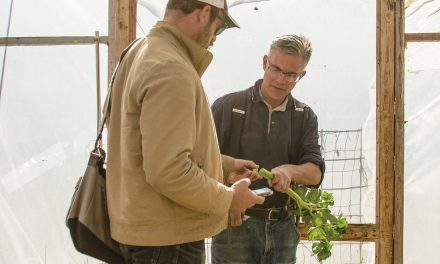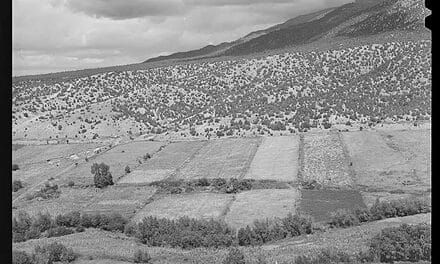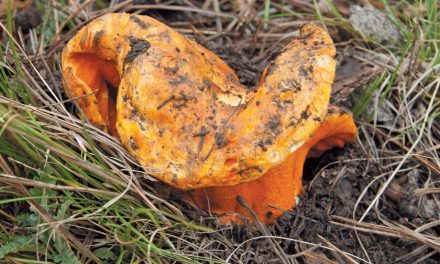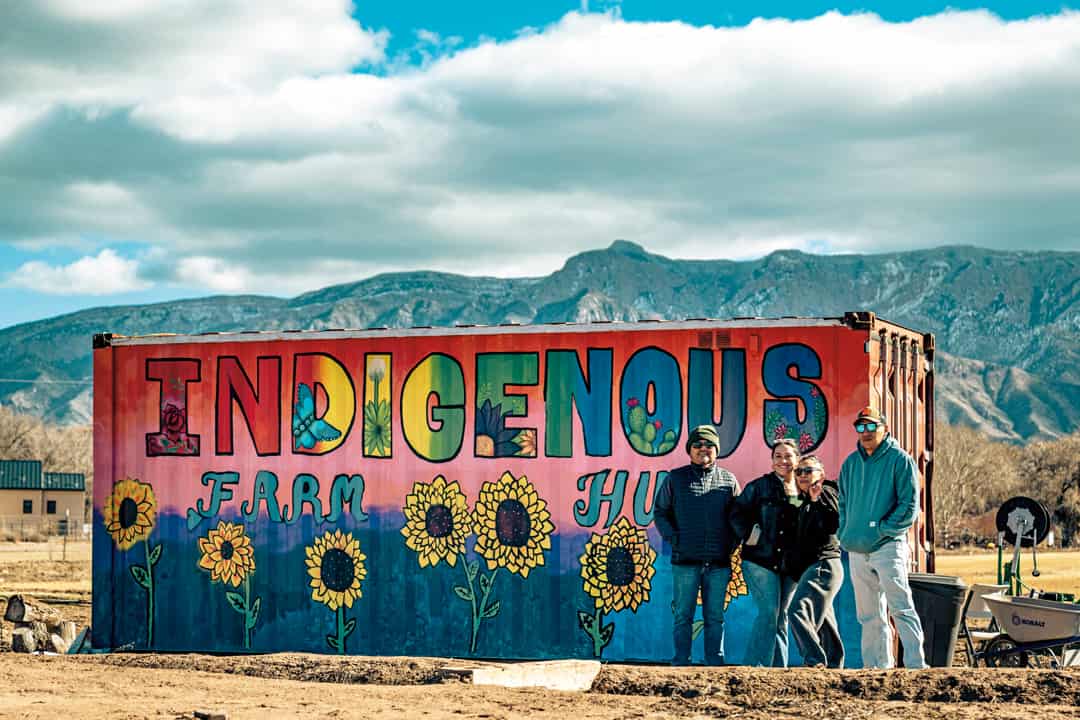Khalsa Family Farms Melds Community and Technology
to Reduce Their Carbon Footprint
By Susan DeFreitas · Photos by Stephanie Cameron

Tarn Taran Kaur Khalsa, chairwoman of the Khalsa Family Farms board of directors; Mark Ridenour, farm manager; and Sirivishnu Singh Khalsa, president of the Khalsa Family Farms board of directors.
Climate change, for many parts of the West, means a future that’s hotter and drier, marked by weather both more extreme and more unpredictable than in the past.
Difficult climatic conditions are nothing new for northern New Mexico, and Khalsa Family Farms in Española is a case in point. “When I started [farming in this area] in 1999,” notes Tarn Taran Kaur Khalsa, chairwoman of the board that runs this nonprofit farm, “I was humbled by the challenges that generations before me experienced in northern New Mexico: the hot spring winds, the surprise of summer hail storms, the blistering sun, and the short growing season.”
One of the farm’s key strategies for meeting those sorts of environmental challenges is its geothermal greenhouse.
The 8,600-square-foot structure features an underground “climate battery,” which utilizes the thermal mass of the soil under the greenhouse to help regulate its internal temperatures. Often called a ground-to-air heat exchanger, the system offers year-round heating and cooling via a ground-source heat pump.
As we took a walk through the greenhouse when I visited in July, farm manager Mark Ridenour pointed out the large metal tubes stationed at various intervals around the ceiling, as well as the big blue pipes sticking out of the ground. “These tubes suck the hot air from the ceiling through a series of underground pipes, and once it’s cool, disperse it—it exhausts out of those blue pipes there.” He went on to explain that in the summer, when the ground-to-air heat exchanger kicks on, the air comes into the system at ninety to a hundred degrees and, after it cools, is emitted into the greenhouse at seventy degrees.
This, in combination with a “wet wall” evaporative cooling system, helps keep the greenhouse environment temperate on even the hottest days. “Between the wet wall and the climate battery,” Ridenour notes, “you know—we really couldn’t live without them.”
The same system works in reverse in the winter, keeping the greenhouse right around forty degrees, even when temps outside dip to five below.
Ground-source heat pumps make use of the fact that no matter what Mother Nature is doing aboveground, the temperature of the earth just five feet below the surface stays between forty-five and seventy-five degrees year round. By using the earth as a thermal regulator, ground-source heat pumps either deposit or extract low-intensity heat, in a way that can be used much like the thermostat in a house.

At Khalsa Family Farms, for example, the farmers will let temps run a little hotter for the muscular tomato plants I saw this summer, which like it hot, but they’ll turn the dial down later on in the season for the peas, which prefer a more temperate climate. Being able to control temperatures in the greenhouse this way allows Khalsa Family Farms to grow food year round, remaining in “perpetual harvest.”
One of the big contributing factors to climate change is the carbon footprint of, well, nearly everything, including fertilizer. Khalsa Farms is an organic operation, run on an ethos of ecological stewardship, so it relies on fish fertilizer, compost, and compost tea rather than chemical fertilizers—and one of the big projects currently under way at the farm is to further cut the carbon footprint of transporting fertilizer by fertilizing with the nutrient-dense water from their fish ponds.
I learned this when I asked Ridenour about the big rectangular, concrete-lined hole in the ground on one end of the greenhouse. “That’s going to be our hydroponic pond,” he explained. “We’ll have an active hydroponic farm, with fish in there, so we’ll be able to have aquaponics as well”—which, he explains, means they’ll be able to fertilize the greenhouse through its drip irrigation system with water fed directly from that pond.
Khalsa Family Farms was established on the campus of the Hacienda de Guru Ram Das Ashram in the village of Sombrillo, just outside Española, in 2018, when a group from that spiritual community came together to construct the greenhouse. One year later, the farm incorporated as a nonprofit with a mission to grow and sell healthy, organically grown produce year round while regenerating the soil, sharing food and supporting food security in the Española Valley, and “provid[ing] beautiful environments that heal and inspire.”
Ninety percent of its farm crew comes to participate in its one-to-ten-month Farm Learning Program, which attracts people from around the country who want to experience hands-on, small-scale organic farming in greenhouses and open fields. Earlier that day, I’d learned that these volunteers worked six hours a day in exchange for room and board, as well as (optional) daily yoga and meditation classes. I ventured to ask if the fish in the aquaponics system would be part of the diet here at the farm.

Ridenour laughed. “No, definitely not. This is a vegetarian community—mostly vegan.” When the aquaponics project is complete at the end of the year, their resident fish population would be able to relax, I imagined, and enjoy the peaceful kirtan music piped into the greenhouse alongside the farm’s volunteers.
Ridenour went on to note that the future pond is positioned in front of the greenhouse’s “wet wall,” which means that when the fans there kick on, they’ll be blowing cool air right across the surface of the water, furthering that evaporative cooling effect, much like a swamp cooler. And just having that body of water there in the greenhouse will further help to cool the greenhouse on hot days—and warm it on cold ones—by acting as a thermal regulator. (“We expect to see maybe a five- or six-degree difference,” he noted.)
Khalsa Family Farms’ commitment to the environment manifests in myriad other ways as well, from the variety and diversity of the crops it grows to the cover crops it employs to its pollinator-friendly companion plantings and the compostable plastic containers it uses for produce sold at farmers markets in Española and Santa Fe.
Walking back toward the “Shady Patch” at the back of the farm alongside Khalsa, I asked if she saw a connection between their spiritual practice as a community and their work here at the farm. She considered for a moment and then replied, “Yoga is not just a series of postures. The word yoga means to join the spirit and the body. I say, get off the yoga mat and grow food, serve others in your local community, and do your part for the climate.”
She notes that in addition to feeding the farm’s volunteers,
community-supported agriculture subscribers, and farmers market patrons, Khalsa Family Farms donated a thousand pounds of produce in 2020 to Barrios Unidos, a nonprofit in Chimayó, when many of their neighbors were short on food.
As we walked, we talked about how, during the pandemic, we’d seen large, centralized food distribution systems break down, in much the same way they do during natural disasters—and what this may portend for the ongoing threat of climate change.
“Support your local farmer now,” Khalsa said, smiling, as we walked the rows, “and they’ll be there for you when you really need them.”
10 Narayan Ct, Española, khalsafamilyfarms.com








